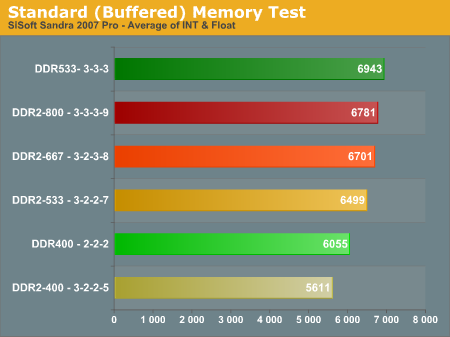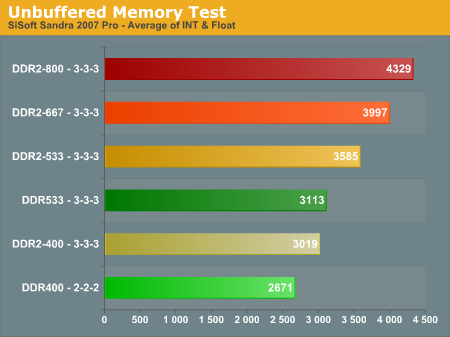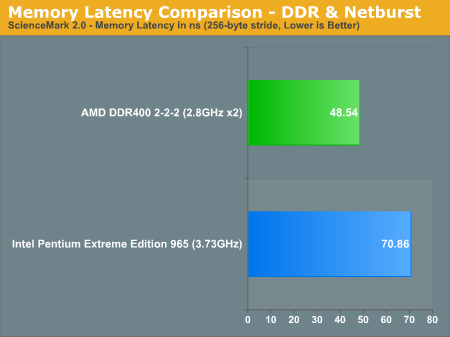DDR/NetBurst Memory Bandwidth and Latency
One of the most talked-about AMD advantages of the last couple of years has been their on-processor memory controller. This has allowed, according to popular theories, the Athlon64 to significantly outperform Intel NetBurst processors. The fact is NetBurst DDR2 bandwidth has recently been similar or wider in bandwidth than Athlon64 - even when the DDR is overclocked. You can see this clearly when we compare Buffered and Unbuffered Bandwidth of a NetBurst 3.46EE to an AMD 4800+ x2(2.4GHz, 2x1MB Cache) running DDR400 2-2-2 and running overclocked memory at DDR533 3-3-3.
The green bars represent DDR memory performance, while the beige to red are increasing DDR2 speed on NetBurst. Light green represents DDR400 2-2-2 while Dark Green is overclocked memory at the same CPU speed, DDR533 at 3-3-3.

In buffered performance, Fast DDR400 is only faster than DDR2-400 and slower than DDR2-533, 667 and 800. Overclocked memory at DDR533 3-3-3 is faster than any of the DDR2 bandwidths on NetBurst.
The Sandra Unbuffered Memory Test, which turns off features that tend to artificially boost performance, is generally a better measure of how memory will behave comparatively in gaming. The same green for DDR applies here.

Without Buffering, DDR400 has the smallest bandwidth of tested memory speeds and timings. Even overclocking to DDR533 allows the DDR to barely beat DDR2-400. DDR2-533, 667, and 800 all have greater Unbuffered bandwidth than the DDR overclocked to 533. NetBurst DDR2 memory bandwidth is generally wider than the bandwidth supplied by DDR memory on Athlon64. Despite the wider bandwidth, the deep pipelines and other inefficiencies in the NetBurst design did not allow the NetBurst processors to outperform Athlon64. Keep this in mind later, when we look at AM2 and Core 2 Duo Memory Bandwidth.
Latency
The other area where AMD has had an advantage over NetBurst DDR2 performance is memory latency, the result of the on-processor memory controller. Comparison of the AMD DDR Memory controller and the Intel DDR2 Memory controller in the Intel chipset shows AMD DDR with latency about 35% lower than Intel NetBurst in Science Mark 2.0.

While memory bandwidth was very similar between AMD and NetBurst, the deep pipes of the NetBurst design still behaved as if they were bandwidth starved. On the other hand the AMD architecture made use of the bandwidth available and the much lower latency to outperform NetBurst across the board.
One of the most talked-about AMD advantages of the last couple of years has been their on-processor memory controller. This has allowed, according to popular theories, the Athlon64 to significantly outperform Intel NetBurst processors. The fact is NetBurst DDR2 bandwidth has recently been similar or wider in bandwidth than Athlon64 - even when the DDR is overclocked. You can see this clearly when we compare Buffered and Unbuffered Bandwidth of a NetBurst 3.46EE to an AMD 4800+ x2(2.4GHz, 2x1MB Cache) running DDR400 2-2-2 and running overclocked memory at DDR533 3-3-3.
The green bars represent DDR memory performance, while the beige to red are increasing DDR2 speed on NetBurst. Light green represents DDR400 2-2-2 while Dark Green is overclocked memory at the same CPU speed, DDR533 at 3-3-3.

In buffered performance, Fast DDR400 is only faster than DDR2-400 and slower than DDR2-533, 667 and 800. Overclocked memory at DDR533 3-3-3 is faster than any of the DDR2 bandwidths on NetBurst.
The Sandra Unbuffered Memory Test, which turns off features that tend to artificially boost performance, is generally a better measure of how memory will behave comparatively in gaming. The same green for DDR applies here.

Without Buffering, DDR400 has the smallest bandwidth of tested memory speeds and timings. Even overclocking to DDR533 allows the DDR to barely beat DDR2-400. DDR2-533, 667, and 800 all have greater Unbuffered bandwidth than the DDR overclocked to 533. NetBurst DDR2 memory bandwidth is generally wider than the bandwidth supplied by DDR memory on Athlon64. Despite the wider bandwidth, the deep pipelines and other inefficiencies in the NetBurst design did not allow the NetBurst processors to outperform Athlon64. Keep this in mind later, when we look at AM2 and Core 2 Duo Memory Bandwidth.
Latency
The other area where AMD has had an advantage over NetBurst DDR2 performance is memory latency, the result of the on-processor memory controller. Comparison of the AMD DDR Memory controller and the Intel DDR2 Memory controller in the Intel chipset shows AMD DDR with latency about 35% lower than Intel NetBurst in Science Mark 2.0.

While memory bandwidth was very similar between AMD and NetBurst, the deep pipes of the NetBurst design still behaved as if they were bandwidth starved. On the other hand the AMD architecture made use of the bandwidth available and the much lower latency to outperform NetBurst across the board.










118 Comments
View All Comments
duploxxx - Thursday, July 27, 2006 - link
please give us edit...powerconsumption is only less in 100% load.... when powermode kicks in the amd is much less consuming... how long do you think a system runs in powermode against full load....
duploxxx - Thursday, July 27, 2006 - link
wrong... the conroe gains from the memory speed the amd more thats a fact... the ones you are referring to are probably 4200 and 5000, well we can say that they perfrom better when using 533/667 because then they don't have the devider issue running the memory on 742 in stead of 800.so the performance/price ratio on those chips is better with 553/667
zsdersw - Thursday, July 27, 2006 - link
Conroe's performance isn't merely a function of memory bandwidth or memory speed.PeterR - Tuesday, July 25, 2006 - link
If you could actually go out and BUY one ?Peter R.
michal1980 - Tuesday, July 25, 2006 - link
Wow. AMD fanboi's pulling out all the crap that the intel fanboi's have pulled in the past.wake up!. Right now, Intel core 2 duo is faster then AMD 64 right now.
Its like video card fanboi's but worse, because the difference here is clear.
If I was building a gaming rig this year, I would build with a core 2 duo.
Just like a few months ago, it would be with an AMD 64.
I go with what company is faster. I used both nvidia cards, and ati Cards. I use pentiums, and p2's, I used athlon xp's when you over clock them 50% ease and they were dirt cheap. I use a opty dual core right now because it was faster then the p4's. I use p-m lappys because of performance/battery life.
If I was building a rig right now. I'd switch to an intel Core 2 duo. Why? because its faster. I could care less about who makes it.
if apple comes out tommorow with a magic pc that runs all pc games run 20% faster, I'm buying an apple.
Pirks - Tuesday, July 25, 2006 - link
I'd buy a iMac or Mac Pro right this second if it were running all PC games at all without rebooting between OS X and XP.yacoub - Tuesday, July 25, 2006 - link
Two things:1 - I think I like the new font used in tables and charts.
2 - In the SuperPi chart you say Lower is Better but then inverse the graph such that it is actually the line higher on the graph that is better. Unless the reader looks closely at the numbers, they could infer that the AMD chip wipes the floor with the Conroe.
redbone75 - Tuesday, July 25, 2006 - link
Seriously, though, here we have a completely new architecture from Intel, the same Intel that is this massive company with enormous resources and huge R&D departments, and these AMD fanboys are still all upset because Intel has not only achieved parity with but also exceded AMD in performance. Come to think of it, this is the exact same argument that AMD fans were using when preliminary benchmarks came out on Conroe. "It's not fair to compare Intel's new architecture to AMD's old one, because they have an advantage." Hey, you want some cheese with that wine? I'll tell you what: AMD enjoyed the performance lead for a while. Now, Intel is having a go at it and, with any luck, AMD will come out on top in the future, at least I really hope so. Why do I hope so? Do any of you think AMD would have lowered their processor prices so much if Conroe wasn't such a threat? Do you think Intel would have released Conroe at these prices if they didn't have to take back the crown from AMD? Hey, with the X2's we still get a great range of processors at much lower prices. Hell, even the Pentium D's are going to be attractive at lower prices. That makes me happy, not some benchmarks saying this processor is faster than that processor. And really, I don't know about you but I don't care about which processor wins memory latency benches, I only care about the end performance in applications I actually use.DigitalFreak - Tuesday, July 25, 2006 - link
Amen, brother!TravelMug - Tuesday, July 25, 2006 - link
As said by several people before - you are not testing latency but the prefetch abilites of the CPU. Same has been said about the original Conroe article, you don`t seem to listen though."Everest from Lavalys shows latency improvements in the new CPU revisions, but it shows Latency more as we would expect in evaluating Conroe. For that reason, our detailed benchmarks for latency will use both Everest 1.51.195, which fully supports the Core 2 Duo processor, and ScienceMark 2.0."
Really? That is a 2 years old version, there have been countless new version since then. Also, if that version "fully supports" the Core 2 Duo processor, how come this is what the developer says about the latest version 3.01?:
http://www.lavalys.com/products/whatsnew.php?pid=3...">Support for Intel Core 2 "Conroe" and "Merom" processors